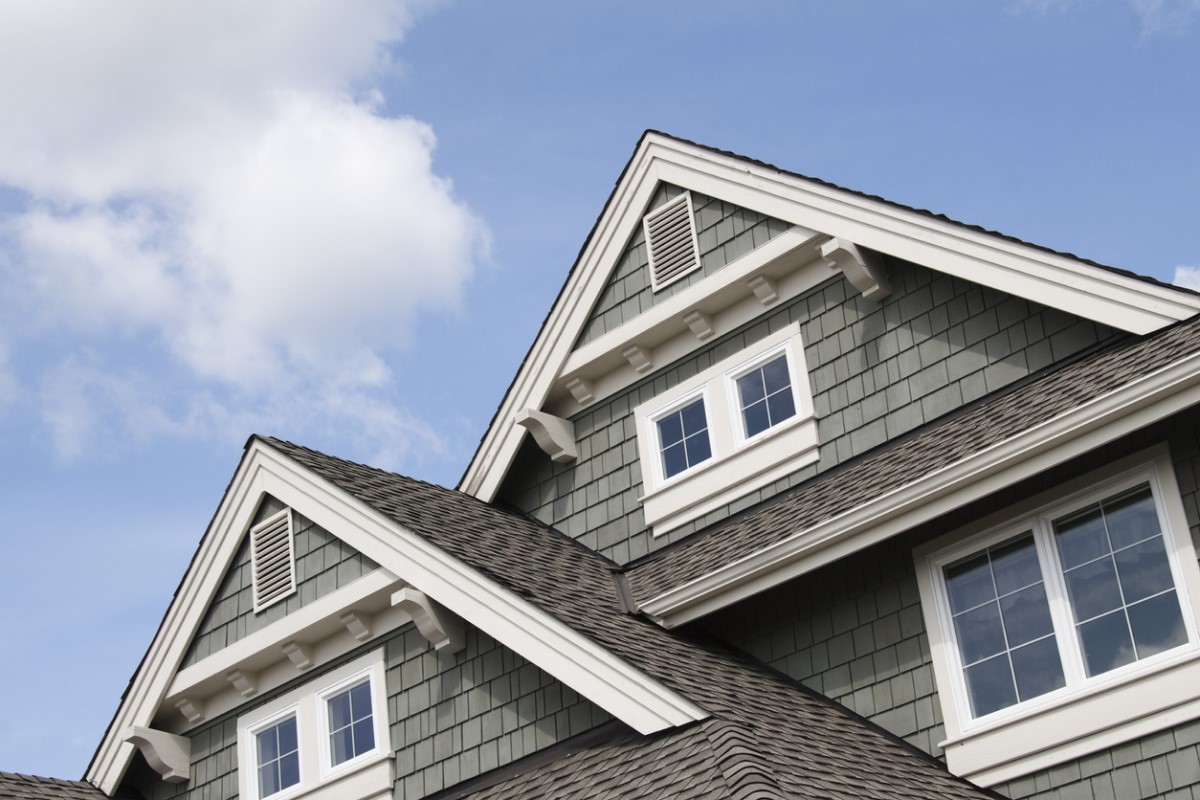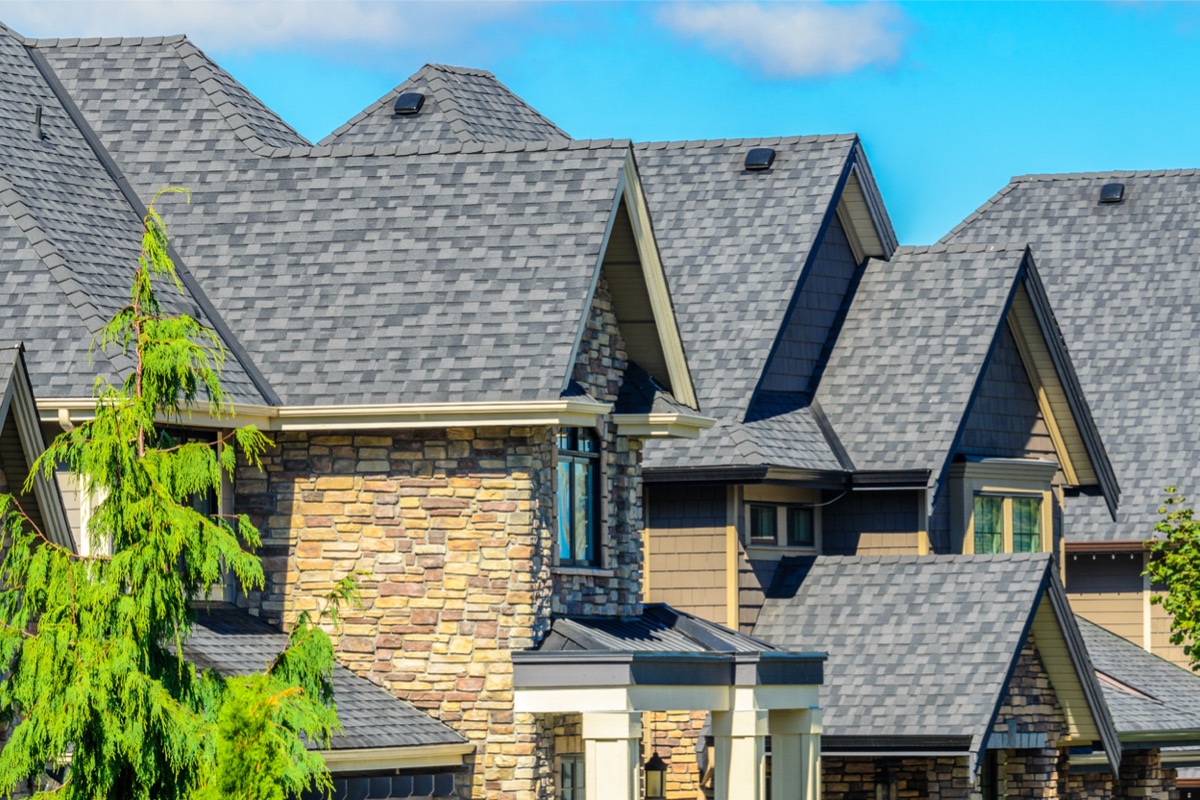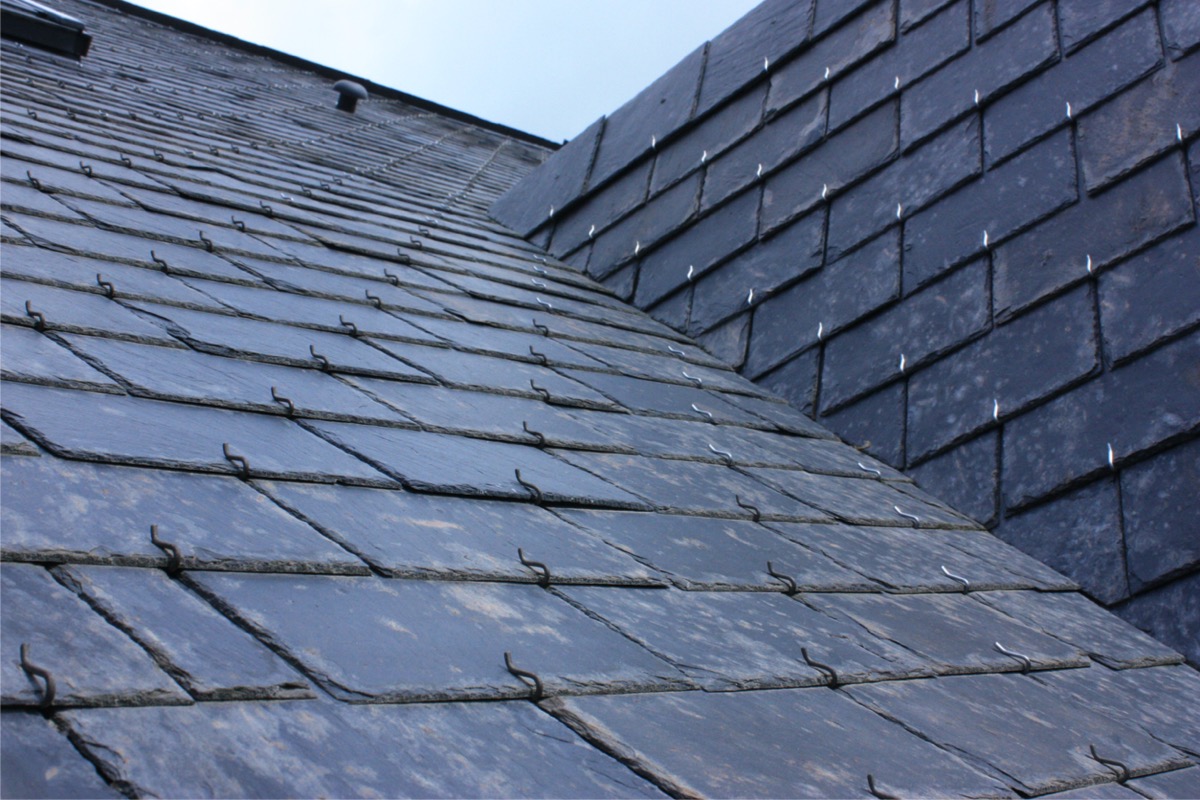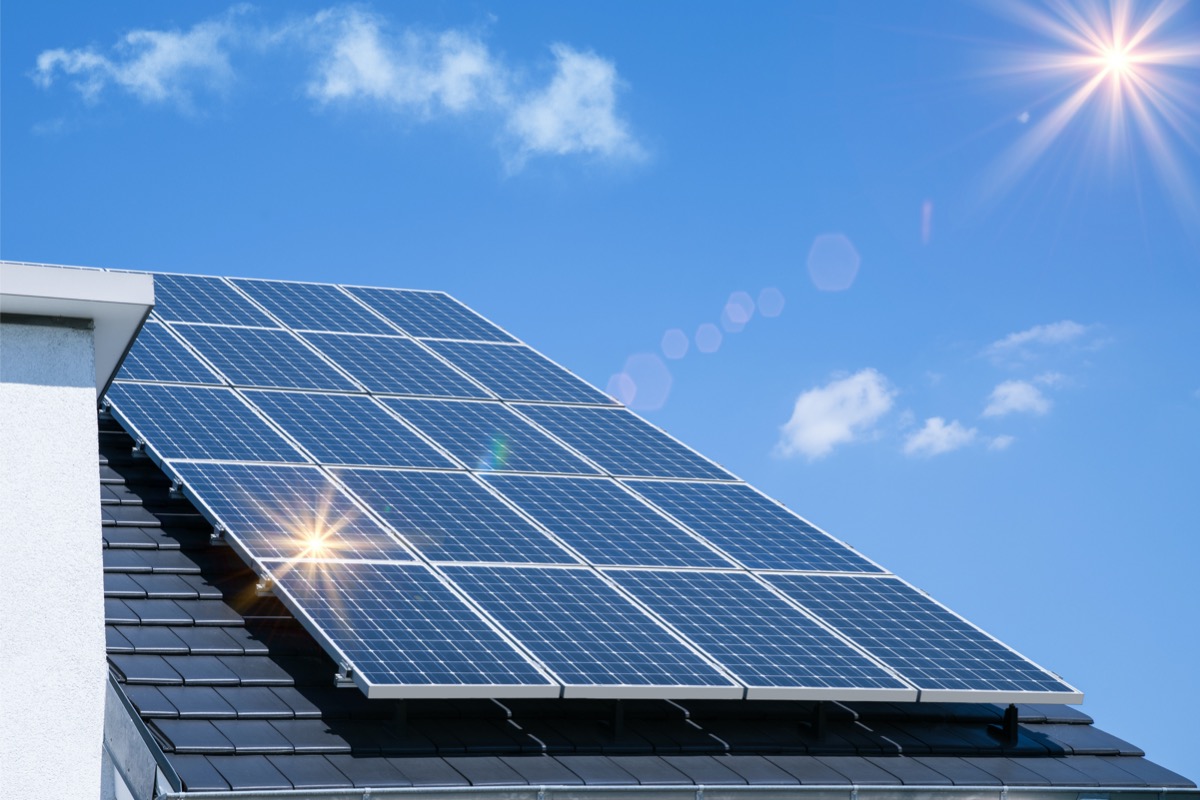

We may earn revenue from the products available on this page and participate in affiliate programs. Learn More ›
Q: We recently bought a house and its roof is 15 years old. While the home inspector didn’t find any specific problems with the roof, I’m concerned that it may be close to the end of its life expectancy. I don’t want to invest in a new roof before it’s necessary, but I don’t want to put it off too long and deal with leaks. So I’m wondering, how long does a roof last?
A: Materials and workmanship—as well as the weather conditions in your area—determine the lifespan of a roof. When installed by a quality roofing company, many types of roofs last longer than 15 years; some can hold up well for 50 years or longer, barring a severe storm or a large fallen tree. Not surprisingly, cheaper types of shingles won’t last as long as more expensive types, and the price range is quite broad.
At the lower end are shingles that cost $70 per square (in roofing terms, a “square” is 100 square feet). At the higher end, the cost of a new roof can be as much as $1,500 per square; shingles at the top price range can potentially last longer than the house itself. Read on to learn how long different types of shingles are likely to last so you can better judge when you’ll need a roof replacement.
The expected lifespan of asphalt shingle roofs is 15 to 30 years.
Asphalt shingles are the most common type of roofing material sold today. They are installed on more than 80 percent of new homes because they’re affordable (averaging $70 to $150 per square) and come with warranties of up to 25 years.
Composed of an asphalt coating over a base of either fiberglass or an organic material such as cellulose, asphalt shingles provide a durable layer of protection from UV rays, wind, and rain. Heat from the sun softens asphalt on the shingles, and over time this helps to bond the shingles in place and form a watertight seal.
Each type of asphalt shingle—fiberglass or organic—comes with its own pros and cons. Asphalt shingles made from organic materials like cellulose are highly durable but pricier than fiberglass shingles. Organic asphalt shingles are also thicker and are coated with more asphalt. Fiberglass shingles, on the other hand, are lighter in weight, which is why they’re often the go-to choice when installing a layer of shingles over an existing roof. As well, fiberglass asphalt shingles have a better fire rating than cellulose shingles.
Both fiberglass and organic asphalt shingles are available in several designs, the most common of which are three-tab and architectural shingles. The most popular is the three-tab shingle, where the lower edge of each strip is cut into three tabs, creating the appearance of three individual shingles. In contrast, architectural shingles (see below) incorporate multiple layers of material for a layered construction that mimics the look of individual shingles, giving a more visually interesting, dimensional look to the roof.
One potential downside to asphalt shingles is their tendency to become damaged by fungus or algae when installed in humid regions. Those who live in particularly wet or humid climates and are considering asphalt roof replacement may want to invest in specially manufactured algae-resistant shingles.
RELATED: Solved! How to Choose Between Roof Repair or Replacement
Architectural shingles, a premium type of asphalt shingle, can last 25 to 30 years.
While architectural shingles seal in the same manner as standard asphalt shingles, they’re up to three times thicker, so they form a denser, more resilient roof. Warranties for architectural shingles reflect this greater durability. Although warranties vary by manufacturer, some stretch to 30 years and beyond.
At $250 to $400 per square, architectural shingles are more costly than their three-tab counterparts, but they are also considered more attractive. Those multiple laminated layers that enhance their durability also let them mimic patterns and textures found in more expensive materials, such as wood, slate, and tile roofs. Because these luxury designs aren’t as pricey as the materials they emulate, architectural shingles can achieve a high-end aesthetic without being cost-prohibitive.
Note that architectural and three-tab asphalt shingles are not appropriate for use on low-slope or flat roofs. They should be used only on sloped roofs with a pitch of 4:12 or more.

Wood shingles can last up to 30 years, but require annual upkeep.
Cedar is the preferred choice for wood shingles and shakes because it’s rot- and insect-resistant. Over time, wood shingles weather to a soft silvery gray and look great on almost any style of house, but they’re especially well suited to Tudor and cottage-style homes with steep-pitched roofs.
You’ll pay $250 to $600 per square for a wood shingle roof. To keep it in good condition, a wood shingle roof should be inspected annually, and any split shingles should be promptly replaced. A well-maintained wood shingle roof should last 15 to 30 years, depending on the quality of the shingles or shakes.
While wood shingles offer a natural aesthetic and are relatively low in installation costs, they come with some drawbacks. Because they’re a natural product, it’s not uncommon to run across a few warped or split shingles during installation, or to encounter disfigurement later, after the shingles are in place. These defects can contribute to leaking or cause individual shingles to pop up.
Wood shakes and shingles are also susceptible to discoloration. Their fresh, brown appearance fades over a few months to silvery gray, which some people prefer. A more concerning issue is wood shingles’ susceptibility to fire, although shakes and shingles treated with fire retardants are available. In fact, in some municipalities code prohibits the use of untreated wood roof shingles. Be aware that installing wood shingles may result in a higher homeowners insurance premium or deductible.
Clay tile roof life expectancy is 50 years or longer, but require professional installation.
While clay tiles are available in a host of earthy colors, this roofing is best known for the bold terra-cotta tones that are extremely popular in the southwestern United States. You’ll pay a hefty $600 to $800 per square to have a clay tile roof installed, but you won’t have to replace it anytime soon. The durable, low-maintenance tiles can easily last 50 years, and manufacturers offer warranties anywhere from 30 years to a lifetime.
Clay tile roofs are especially popular in hot, sunny climates where intense heat from the sun can soften the underside of asphalt shingles, weakening the adhesion and leading to roof leaks. While they’re called “clay” tiles, and some are actually made of clay, today’s clay tiles are for the most part made from tinted concrete that’s been molded in curved, flat, or interlocking shapes.
Installation of clay tiles isn’t a DIY project. The tiles are heavy and brittle, and they must be installed in defined patterns that require precise measuring. Additionally, because clay tiles can weigh up to 950 pounds per square, replacing an old asphalt roof with clay tiles may require beefing up the home’s roof structure.

Metal roofs are attractive and durable, and can last up to 70 years.
Metal roofing runs the gamut in price and quality, starting around $115 per square for standing-seam panels in aluminum or steel and reaching up to $900 per square for stone-coated steel tiles and standing-seam copper panels.
When it comes to metal roofing, quality also relates to thickness; the thicker the gauge (the lower the number), the more durable the roof will be. At the cheaper end, you’ll find thinner metals (26 to 29 gauge) with a lifespan of 20 to 25 years.
High-end metal roofing (22 to 24 gauge) is popular in northern regions because of its ability to send snow sliding from the roof, and it’s durable enough that it can easily last more than half a century. Manufacturers offer warranties ranging from 20 years to a lifetime, depending on the quality of the metal. As a bonus, metal roofing has a smaller carbon footprint than asphalt because of the significant amounts of petroleum products used in the manufacture of asphalt shingles.
A potential downside to metal roofs is that they can be dented by falling tree branches or large hail. Dents are virtually impossible to remove and can often be seen from a distance, which mars the appearance of the roof. For those who live under a canopy of trees or in an area that gets a lot of hail, consider going with a metal roof made from steel rather than aluminum or copper to help reduce the risk of dents.
A slate tile roof’s lifespan is a century or longer.
Slate, a natural metamorphic stone with a refined grain appearance, is perfect for cutting into uniform roofing tiles. Though a pricey option, running from $600 to $1,500 per square, a slate roof can take just about anything Mother Nature dishes out (except perhaps a powerful tornado), retaining its structural integrity and beauty.
Slate tile manufacturers offer warranties ranging anywhere from 50 years to a lifetime, and should a slate tile ever break, it can easily be replaced. The biggest downside to slate tile roofs (besides the cost) is weight. Standard roof framing is not suitable for supporting these heavy tiles, so the roof’s rafters must be reinforced before a slate roof can be installed. The other thing to know about slate tile roof installation is that it is not DIY-friendly. Precision is critical when installing slate tiles, and it takes an experienced roofing contractor to keep the tiles from shedding layers during the process.
Those looking for a fireproof roof won’t go wrong with slate tile. Because it’s a natural product, it’s also eco-friendly. The slate can even be repurposed when its roofing life is over.

Solar roofing tiles are a new technology, and are thus a little pricey.
Solar panels installed on traditional roofs are commonplace these days, but solar roofing tiles are still in their infancy. On the upside, they’re more attractive than large solar panels, but they’re also pricey, costing up to $22,000 more than regular solar panels. Unfortunately, solar tiles aren’t quite as energy efficient as solar panels because they don’t generate as much power. In general, today’s solar roofing tiles produce about 23 percent less energy than standard solar panels.
On the plus side, solar tiles come with warranties of 30 years to life, and a single damaged tile is relatively easy to replace (although it requires a professional to do so). Initial installation of solar roofing tiles should also be left to the pros. The technology is advancing rapidly, and as solar roofing tiles are manufactured on a greater scale, they will probably come down in price.

Start benefiting from solar.
Bob Vila has partnered with EnergySage to help you compare multiple quotes for rooftop solar panels from vetted installers in your area.Get Free Quotes

Final Thoughts
In general, roofs can last anywhere from 20 to 100 years, depending on the materials used, the quality of the workmanship, and the climate. Not surprisingly, the most durable materials also cost the most. A variety of colors and designs are available to suit any home style, but selecting a new roof is about more than just picking a color. It’s important to choose a roofing material that’s suited to your region’s climate and the roof’s slope. Note that it’s always a good idea to have a roof installed by a professional roofing crew, but for dedicated, capable DIYers, asphalt roofs are the easiest to install.
FAQs About Roof Life Expectancy
Replacing a roof is a pricey proposition. Before you get started, it’s important to research your options in both roofing materials and contractors. If you’re thinking about having a roof replaced, here are some answers to questions you’re likely to have.
Q: How often should a roof be replaced?
The short answer: Before the existing roof leaks. Lifespans vary according to the type of roof. For instance, three-tab asphalt shingles last around 25 years, while architectural shingles last up to 30 years. A wood shingle roof can last up to 30 years, but individual shingles may need replacing before that. A clay tile roof will last an average of 50 years, while metal roofs last from 20 to 70 years, depending on quality. Slate roofs can last up to a century, and solar tile shingles are expected to last about 30 years.
Q: How do you know when it’s time to replace your roof?
It’s time to get a new roof when it reaches its maximum expected lifespan, even if it still looks good. Other indications that it’s time to replace a roof include damage from hail or falling branches, curling shingles, missing shingles, and roof leaks.
Q: How do you tell if your roof is damaged?
Visible signs of damage include broken or missing shingles or tiles, leaks on the ceiling indoors, sagging sections of roof, and missing or torn tiles. Not all signs are visible to the untrained eye, however, so if you suspect damage, call a roofing pro to come out and inspect the roof.
Q: How long does it take to replace a roof?
It can take approximately 3 to 5 days to replace an asphalt or architectural roof, depending on the weather and the size and complexity of the job. Other roof types can take from a few days to a couple of weeks. Rain, snow, or inclement weather can prolong replacement.
